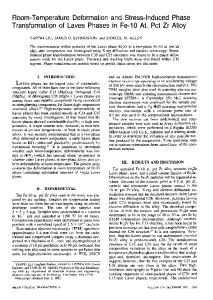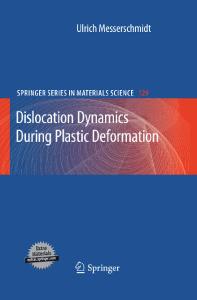Stress Patterns of Deformation Induced Planar Dislocation Boundaries
- PDF / 210,333 Bytes
- 6 Pages / 612 x 792 pts (letter) Page_size
- 102 Downloads / 260 Views
Stress Patterns of Deformation Induced Planar Dislocation Boundaries Shafique M. A. Khan1, Hussein M. Zbib1, Darcy A. Hughes2 1 School of Mechanical and Materials Engineering, Washington State University, Pullman, WA 99164-2920, USA. 2 Center for Materials and Engineering Sciences, Sandia National Laboratories, Livermore, CA 94550, USA. ABSTRACT A Multi-scale model coupling discrete dislocation dynamics with continuum plasticity and finite element analysis is used to study the self-stress field of geometrically necessary (dislocation) boundaries (GNBs). The results for a single GNB are presented here. The internal structure of the GNB is obtained from the Frank’s formula using experimentally measured misorientation angle/axis pair as the input. Several different types of model boundary conditions (using FEA) are analyzed together with the effect of different parameters like the domain length and mesh sensitivity. It is shown that choosing the right boundary conditions for the FEA strongly affects the predicted internal stress fields of these dislocation boundaries, particularly the long-range effect. INTRODUCTION The evolution of dislocation walls and cell structures during plastic deformation plays an important role in determining the overall deformation behavior of the material, and therefore it has been a topic of high interest among researchers working in the field of deformation and plasticity. It is well established that during plastic deformation, dislocations move and arrange themselves in certain patterns that are characteristic of the plastic deformation history. Considerable effort has been devoted to characterize and model these dislocation structures for better understanding of the deformation process. Several experimental and theoretical studies have been carried out to investigate the dislocation distributions during plastic deformation. One of the dislocation arrangement phenomenon observed is the formation of areas with dense dislocations and areas free of dislocations, frequently referred to as dislocation walls and cells respectively. A composite model is proposed by Mughrabi [1-2] to explain the origin of the longrange internal stresses. This model takes into account the heterogeneity of the structure and models the dislocation walls and cell structures at microscale like a composite material at macroscale with different properties for the two phases of the composite. It was suggested that long-range internal stresses develop as a result of compatibility requirement between hard (wall) and soft (cell) materials. Another theory to explain the formation and characteristics of dislocation walls was developed by Kuhlmann-Wilsdorf [3-4] and is referred to as the LEDS (Low Energy Dislocation Structures) theory. As the name implies, dislocations assemble into LEDS, which by definition are structures in which the dislocation stresses are screened out to the level of friction stress at near neighbor distance. Among those structures that are accessible to the dislocations, dislocations tend to form a struc
Data Loading...











